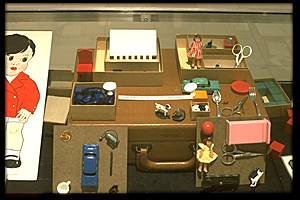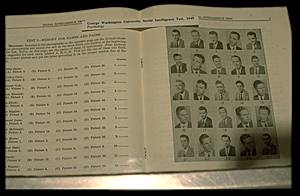What and how we measure varies from discipline to discipline. But perhaps the two most common axes are space and time. Nonetheless, how each field thinks about space and time, or what it is most interested in finding out, can seem completely foreignfrom the perspective of other fields.
Most of the scientific tools we have included thus far, like those used by geology or the physical sciences allow us to see and examine the visible world. The tools of psychology are meant to help us to understand human minds, even if some of the tools seem disturbingly out-of-date.
Blocks from IQ tests
Psychology
Fostering intelligence - the ability to absorb and understand knowledge - is the ultimate goal of a university and its collections. In this century, psychologists have tried to measure intelligence and other mental characteristics using a great variety of tests. But our understanding of the nature of the mind has changed greatly, and hence the tests we use to analyze it have also changed. Some of these tests are still in use; other are decidedly out of fashion, very obviously a product of their historical context.
Images of mental patients from the Szondi Test, 1940s
Psychology
Dr. Lipot Szondi believed that the mental problems presented here were genetic - caused by latent recessive genes. They were divided into eight "disorders" arranged in opposite pairs: homosexual and sadist, epileptic and hysteric, catatonic and paranoid schizophrenic, depressive and manic. Test subjects were asked to identify the faces they liked and disliked the most. These preferences, Szondi argued, were due to shared genetic information: subjects reacted strongly to disorders they, latently, also carried. Phrenology or "physiognomic science," the old belief that one could read inner truths from people's faces, still influenced some scientists less than fifty years ago.
George Washington University Social Intelligence Test
Psychology
The George Washington University Social Intelligence Test examined a subject's ability to memorize names and faces; the subject was asked to study a page of photographic portraits matched with names, and then recall which names went with which faces. What strikes today's viewer about this test, developed in the 1950s, is that it presents a remarkably homogeneous social world populated entirely by young, white middle-class men. As well as ostensibly testing for social intelligence, the test itself constructed a particular definition of this type of intelligence and of society itself - a definition today's standards of social acumen demands we question.





